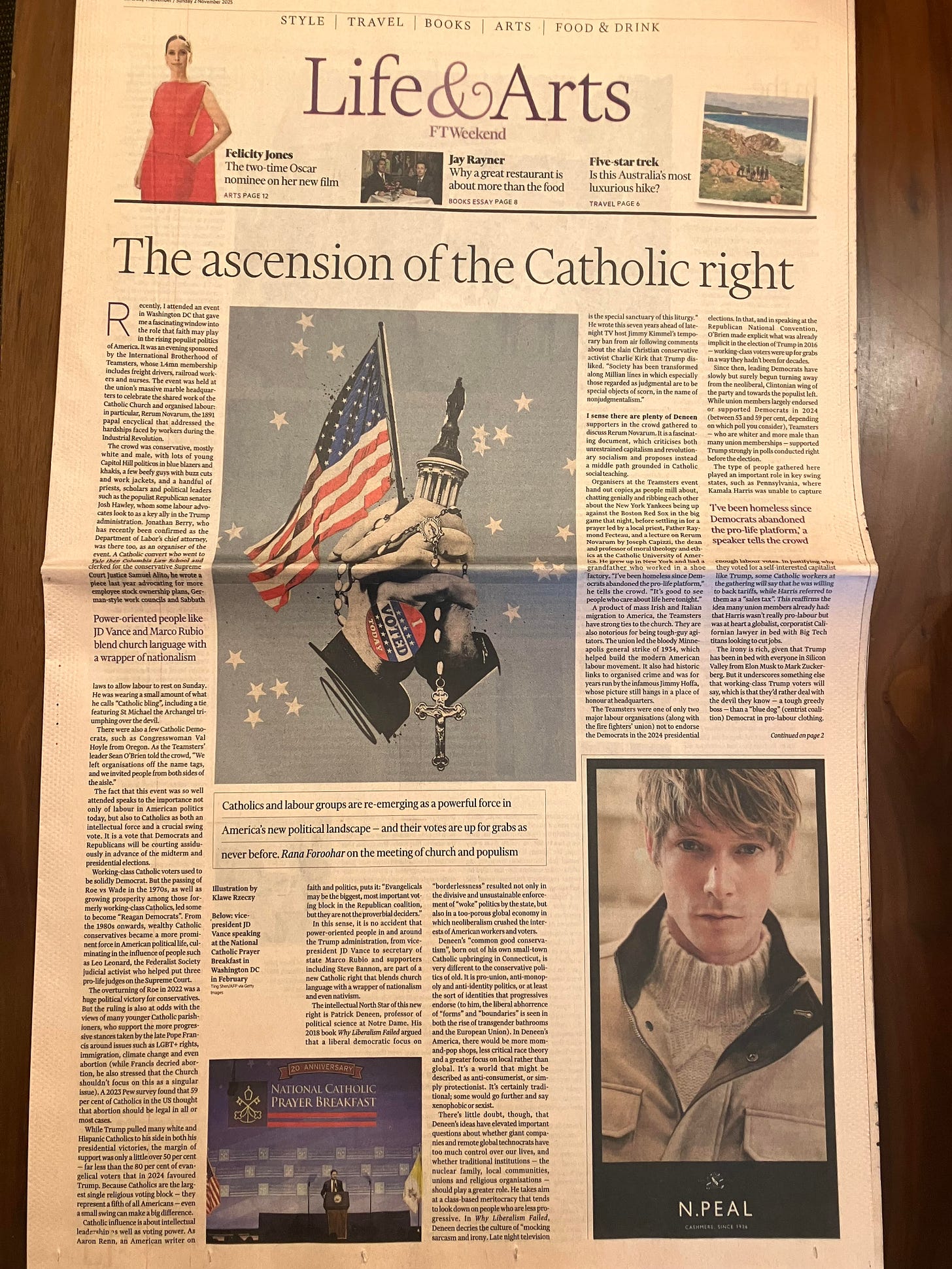The Rise of the Catholic Right
Right-wing Catholics, techno-optimism, social media driving polarization, and more in this week's digest.
I know it’s last minute, but those of you here in Indianapolis have a rare opportunity to see me speak locally at the Maven conference tomorrow.
As you know, the Financial Times is my favorite newspaper, so it’s always a delight when I’m quoted in it, as I was last weekend in a great essay by Rana Foroohar on the rise of the Catholic right in America.
Catholic influence is about intellectual leadership as well as voting power. As Aaron Renn, an American writer on faith and politics, puts it: “Evangelicals may be the biggest, most important voting block in the Republican coalition, but they are not the proverbial deciders.”
In this sense, it is no accident that power-oriented people in and around the Trump administration, from vice-president JD Vance to secretary of state Marco Rubio and supporters including Steve Bannon, are part of a new Catholic right that blends church language with a wrapper of nationalism and even nativism.
The intellectual North Star of this new right is Patrick Deneen, professor of political science at Notre Dame. His 2018 book Why Liberalism Failed argued that a liberal democratic focus on “borderlessness” resulted not only in the divisive and unsustainable enforcement of “woke” politics by the state, but also in a too-porous global economy in which neoliberalism crushed the interests of American workers and voters.
…
Certainly, you could make the case that there’s been little fundamental difference between a corporatist Democrat and a Chamber of Commerce Republican during the past few decades. Both have supported financial deregulation, industrial outsourcing and other policies that have resulted in wealth and power being concentrated in a handful of coastal cities.
Click over to read the whole thing. Unfortunately, the FT has a very hard paywall and lacks an NYT style gift link sharing system, but you can give it a shot.
This was the weekend essay that ran on the cover of the FT Weekend’s Life & Arts section. You can’t get better placement than that.
Techno-Optimism or Techno-Pessimism
I was also a guest on the Intercollegiate Studies Institute’s “Project Cosmos” podcast, in an episode about techno-optimism and techno-pessimism. The other guests were Ross Douthat (NYT columnist), Matthew Walther (editor of the Catholic journal the Lamp), Michael Miller (Acton Institute), and Frank Hanna (entrepreneur, investor, and philanthropist). Johnny Burtka of ISI moderated.
Interestingly, I was the biggest techno-optimist. Perhaps that’s because I was a technologist myself in a previous life. I’m actually a very good software developer who still writes code on occasion to help with my research projects.
I also think this shows a bit of the Protestant-Catholic divide on technology, with the Protestant perspective being more pro-tech and the Catholics more tech-skeptical. Timon Cline wrote an analysis of our discussion that talks further about this.
Beauty Advent Calendars
The Financial Times also told me about the growth of the market for so-called beauty advent calendars, which sit at the intersection of multiple trends I frequently cover: kidulting and the rise of the affluent top 10%.
The purpose of the party was a launch — not of a brand or a new fashion collaboration, but of a calendar. The Liberty Beauty Advent Calendar 2025 costs £275 and contains 30 products, with a total retail value of £1,245. Liberty expects it to sell out by early November.
“This is our biggest beauty project of the year, and each year we try to achieve something greater than what came before,” says Laura Freitas, beauty buyer for curated product at Liberty. She began working on the 2025 calendar in April 2024 and the retailer has increased its order by about 30 per cent each year to meet demand; 60 per cent of last year’s customers were first-time advent calendar buyers. Beauty retailer Space NK ordered thousands more units of its £260 set for 2025 in a bid to keep pace with demand and on the day John Lewis launched its advent calendar, it was the fastest-selling item across the whole store, excluding Apple products.
Not long ago, advent calendars were for children: countdowns from December 1 to Christmas with a chocolate or trinket hidden behind every tiny numbered door. But in recent years they have undergone a secular glow-up that doesn’t have anything to do with spiritual preparation to celebrate the birth of Jesus. Instead luxury brands offer luxury calendars themed around skincare, beauty, candles, jewellery, fragrances and more. And, yes, there are even advent calendars for pets.
Click over to read the whole thing.
Apparently these have been a thing for a while, but not being the target market, I hadn’t heard about them.
Social Media and Polarization
The Financial Times has been on a tear lately, so I have another piece from them, this one from the great John Burn-Murdoch on how American style polarization is spreading to the rest of the West - and now the media incentive structure helps drive it.
In their pioneering paper The Business of the Culture War, published earlier this month, MIT and Harvard economists Shakked Noy and Aakaash Rao use second-by-second TV viewing data to show how the commercial incentives of cable news channels helped to sow discord not only among their viewers but across America more broadly.
Their key insights are that content relating to crime, immigration, race, gender and criticism of elites reliably increases viewing figures (while economics and healthcare cause people to switch away). This means there is a resulting shift in coverage towards more culture war issues and fewer socio-economic stories, which leads voters to rate these issues as more important. Politicians then respond by campaigning more on cultural hot button topics. All told, they estimate that the emergence and growth of cable news can account for fully one-third of the increase in US cultural conflict since 2000.
…
The researchers simulated a social media app, fed it with hundreds of posts, and then monitored how the types of content that appeared in people’s feeds changed depending on whether the app simply showed them a representative mix of all posts, recommended the posts most liked or shared by others, or simulated a TikTok-style algorithm that surfaced posts depending on how long other people spent looking at them.
The results were striking. Relative to the counterfactual of simply showing people an even mix of all content, the recommendation algorithm based on likes and shares (essentially how social media worked during the 2010s) consistently boosted posts that praised the viewer’s in-group and blamed their out-group, as well as pushing much more political messages into people’s feeds.
Here’s a chart of the evolution in social media algorithms.
Click over to read the whole thing.
Best of the Web
WaPo: MAGA singles are looking for love in Washington. It’s a challenge. (gift link)
Samuel James: Female Culture is Being Pornified
NYT: For These Women, the American Dream Is in Mexico City (gift link) - Thousands of foreign women have moved to the Mexican capital for a “life reset,” creating successful businesses and drawing more expats like them. Not all Mexicans are pleased.
I have long said that the real metric to look for in terms of America being in real trouble is large scale expatriation by the native born population. The migration in this article is still small scale, but interesting to see. There’s also a rich irony that a handful of Americans moving to Mexico causes consternation when tens of millions of Mexicans have moved here.
Matt Stoller: Addiction Markets: Abolish Corporate-Run Gambling - Corporate gambling is economic coercion, a way to shift tax burdens away from the wealthy to the poor. It’s been here since the 1970s, and now it’s corrupting sports and young men.
The Guardian: An ex-Intel CEO’s mission to build a Christian AI: ‘hasten the coming of Christ’s return’ - As they say, big if true
Ryan Burge: Have we reached peak Nones? - No
New Content and Media Mentions
As noted, I was quoted in the Financial Times this week. Desiring God also referenced a post by Justin Powell that was published here.
New this week:
It’s a Boomer, Boomer, Boomer, Boomer World - Much of what we think of as American culture is really just the cultural preferences of white Boomers
Poverty and Pumpkinscaping - The growing divide between porch elites and penny-pinchers means populist fire is inevitable
My podcast this week is with Leah Libresco Sargeant on her new book The Dignity of Dependence.
My Member only podcast is about why conservatives struggle to build media and culture companies. I also have some thoughts about the recent controversies regarding celebrations of Diwali.
Subscribe to my podcast on Apple Podcasts, Youtube, or Spotify.
Cover image: Patrick Deneen






I can't tell if Ryan Burge is threatening us lol